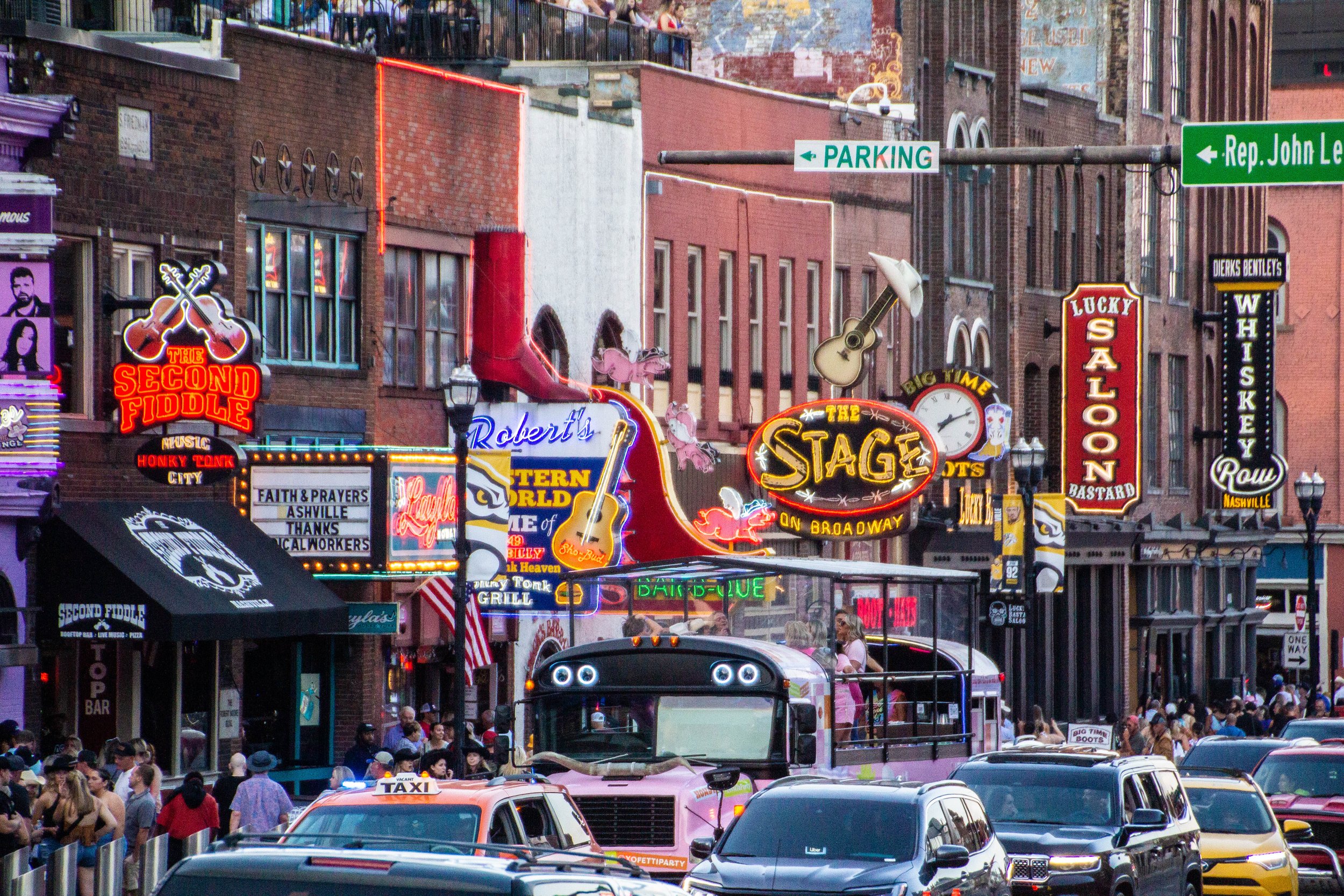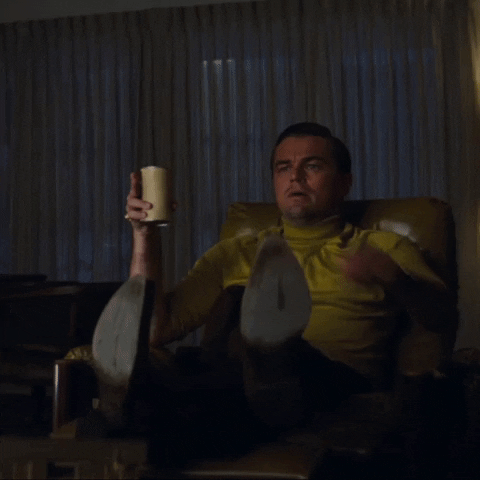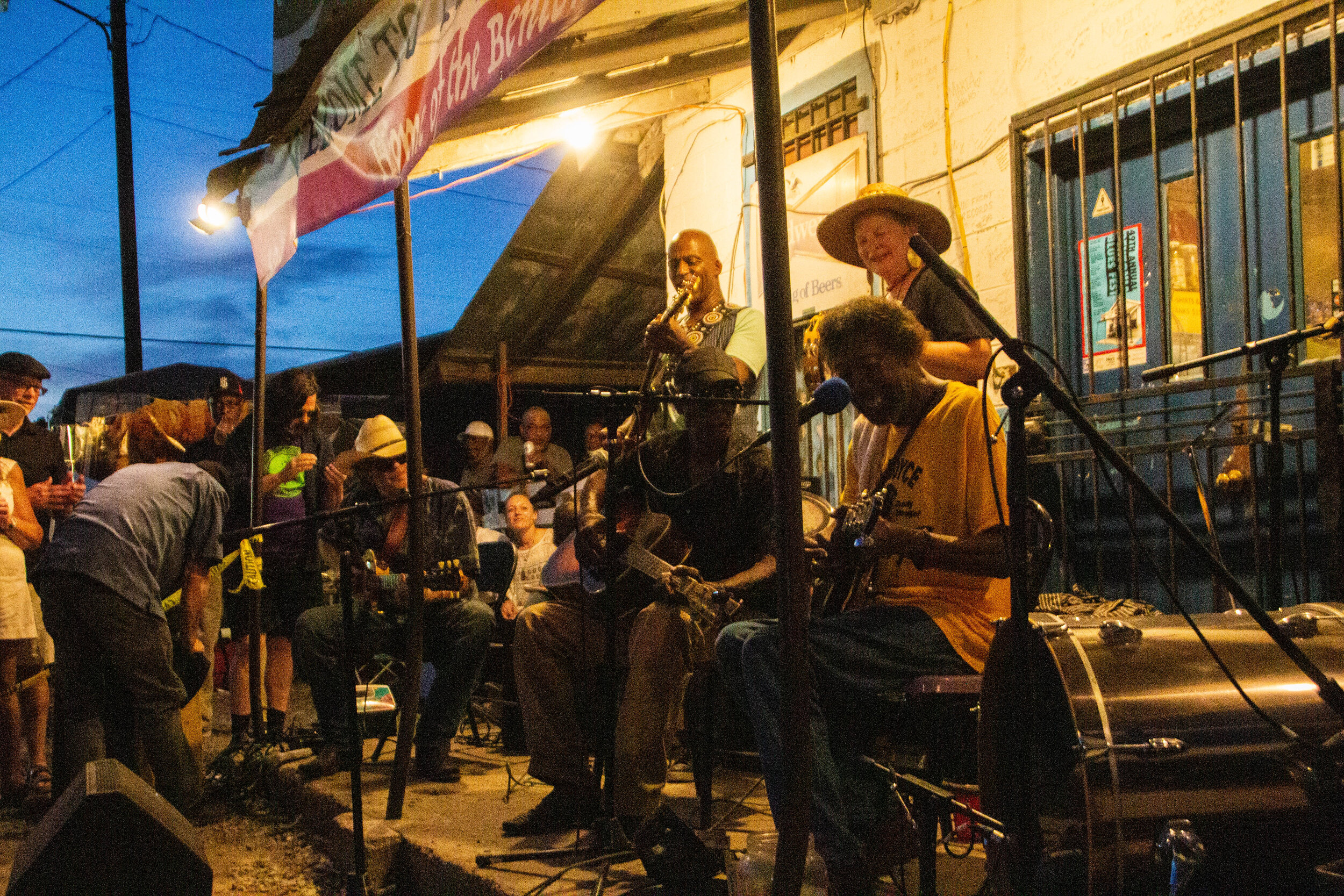Have you ever been to Nashville? Or considered visiting? If so, you probably became aware of Nashville’s equivalent of the Las Vegas strip: Broadway. This crowded strip of Honky Tonk bars boasts kitschy bright neon signs and—because this is ‘Music City’—round-the-clock live bands. Indeed, this is an A-list attraction in Nashville, constantly awash with tourists. It is estimated that as many as 15 million tourists will visit Broadway in a year. To put that in perspective, that is more people than visit Brazil and Argentina combined in a year. So, I am never surprised when I hear stats saying that a single bar on Broadway can bring in as much as $20 million in a calendar year. Nash-vegas is a cash cow!
Whether or not these kinds of country bars are “your scene,” there is one thing that can be said for certain about Nashville’s Honky Tonks: they are the genuine artifact. Almost anywhere else you would encounter this kind of atmosphere, it would be a rip-off of something else. But THESE bars are the O.G.s. It was here that the “Father of Country Music” Jimmy Rogers started playing at bars almost a century ago in the 1930s. The area has gone through some ups and downs over the past 100 years, but today Broadway is enjoying multiple consecutive decades of economic growth.
Yes, if the articles on the Internet are to be believed, Music City is the place to be! Over the past few years, it has become an oft-recited fun fact that more than ~100 people are moving to Nashville each day. I can guarantee you that almost every single one of these people knows Nashville’s nickname, ‘Music City,’ and will visit Broadway—and maybe even the nearby Country Music Hall of Fame—in the first 6 months of living here.
However, very few of them will have ever heard of the other side of this coin: Jefferson Street.
What Is Was Jefferson Street?
Roughly 14 blocks north of Broadway, you will come across a sign for Jefferson Street. There’s nothing much happening there today, but once upon a time, it was booming.
Like most race-related stories set in the American South, the story of Jefferson Street began during the Civil War, when Nashville was occupied by Union Troops. Just north of Nashville, along what is now Jefferson Street, a temporary encampment of newly-freed slaves began to grow. After the war, some of America’s best-known all-Black colleges were founded here: Fisk University in 1866, and Meharry Medical College in 1876. In fact, the famous Fisk Jubilee Singers are the group that earned Nashville the nickname ‘Music City’ in the first place. They were performing for England’s Queen Victoria in 1873, and she remarked something to the effect of “…with such beautiful voices, they had to be from the Music City capital of the United States.”
Yes, even as far back as the 1800s, Nashville’s reputation as a hub for music preceded it. As time went on, the area around Fisk and Jefferson Street became a thriving Black neighborhood and was increasingly home to a multitude of music venues, from speak-easys to dance halls to nightclubs. As a result, Jefferson Street became something of a destination for soul, blues, jazz, gospel, and R&B artists touring the country. During the “Golden Years” of Jefferson Street, which officially stretched from 1935 to 1965, a laundry list of famous Black artists performed here, including (among many others) Aretha Franklin, Count Basie, Muddy Waters, James Brown, Etta James, Little Richard, Charley Pride, Otis Redding, DeFord Bailey, Fats Domino, Ray Charles, B.B. King, and a young Jimi Hendrix. In fact, Jimi Hendrix cited his time performing on Jefferson Street as when he really came into his own as a guitar player. Alongside these venues and musicians was a robust supporting ecosystem of pioneering Black radio and television shows with national reach as early as the 1940s and 1950s. But it wasn’t only about the music; this was also a district full of thriving Black-owned businesses. Both musically and economically, Jefferson Street was booming while Nashville’s country music scene was still in its infancy.
…can you see where I’m going with this?
How weird that all these years later, in the 21st century, Nashville is ubiquitously known for country music (a predominantly white genre, historically), while all of this soul, blues, jazz, gospel, and R&B music (predominantly Black genres, historically) has been relegated to the history books. What happened?
Well, as the 1950s were getting going, first there was the city-sanctioned Capitol Hill Redevelopment Project, which heavily targeted the Jefferson Street community and its infrastructure. More than 1,000 residents of this district were forcibly relocated out of this area, the vast majority of whom were Black. Additionally, the historic Black night clubs the Bijou Theater, and The New Era were torn down, along with the public transit and taxi infrastructure. Forthcoming city ordinances and regulations took aim at shutting the district’s nightlife down entirely, but the real death blow was yet to come. In the 1950s, the city was planning to build Interstate 40 near Vanderbilt University, which at that time was a whites-only institution. Ultimately, the city government changed its mind and decided to build Interstate 40 right on top of Jefferson Street, breaking up this thriving Black neighborhood. This was actually a pretty common tactic used against Black communities around the U.S. at this time, so Jefferson Street was hardly an outlier in this sense. And when this project was completed in the mid-1960s, the “Golden Years” of Jefferson Street ended and the area swiftly entered a long period of economic decline.
So let’s fast-forward to the present day…
Today, the best window into the Golden Years of Jefferson Street is the Jefferson Street Sound Museum. It occupies an unassuming little building on the western side of Jefferson Street, and is only open to the public 5 hours a week, from 11:00am-4:00pm CST on Saturdays. You can book a tour any other time you’d like, but I chose to just show up during those 5 hours. As notable as this history should be, I get the sense that they don’t get a ton of visitors, because I was the only off-the-street person in the building, and they seemed kind of surprised to see me. Luckily, this meant I got a private tour and got to meet the owner of the establishment, Mr. Lorenzo Washington himself!
This museum really is worth a visit! They are extremely nice people and their small space is DENSE with historical artifacts and information that you’d be hard-pressed to see represented anywhere else in Nashville. The whole story points a painfully obvious finger at the racist past of Nashville, but this was a mostly implicit element in their narrative. Maybe it was the mysterious Southern social graces at work, or maybe they just felt awkward beating the racism drum too overtly around me since I’m a white dude, but when I asked some race-adjacent questions, they instead chose to emphasize how open and collaborative the dynamics had been between Nashville’s Black and White musicians historically, behind the scenes. That was definitely nice to hear, and as somebody who was a very active member of Nashville’s current music scene not too long ago, I think I speak from a place of some authority when I say that this is in keeping with the dynamics today as well. The artists actually making the music for which “Music City” is famous are a MUCH more progressive and open-minded bunch than Tennessee’s legislators represent. But that doesn’t change the injustice of it all.
Here are a few pictures from my visit to Jefferson Street Sound Museum.
A Photo Walk of Nashville’s Jefferson St.
So what’s left of Jefferson Street today? I busted out my trusty camera and took a photo walk down these historic stretches of Jefferson Street, as shown on the map below. There is some dope street art along this stretch! Credit to the artists that I could track down is at the foot of the gallery below.
Here are the artists that are responsible for the beautiful murals in this gallery. Or, the ones I could track down at least. As always, if I missed somebody, please reach out and let me know!
James R. Threalkill (@jamesthrealkillart)
Thaxton Abshalom Walter
Lowkeyart (@jamersonsgc)
Yusef Hubb (@doughjoe)
A Photo Walk of Nashville’s Broadway
Now let’s contrast that with a similar photo walk down Broadway. See if you can spot the differences.
As before, here’s a map of where this walk took place. It’s really just a stone’s throw away from Jefferson Street!
Peter’s Perspective 🤷🏻♂️
The point here is really not anything in particular that is on Jefferson Street or Broadway. It’s the difference between them; the disparity. I don’t know if I have seen two objects more directly comparable than Jefferson Street and Broadway. In their respective hey-days, they are/were extremely similar. The key difference here is—to over-simplify/put this bluntly—Broadway is mostly for White people, and Jefferson Street is… or was mostly for Black people.
If the Jefferson Street district had not been broken up decades ago… just imagine what it might have looked like today! If Broadway is any indicator, it could have been a destination unto itself. Putting the moral issue of racism aside just for a moment, this is a huge missed opportunity for Nashville both culturally and economically. Remember, this is not some random city in the South; this is Music City we’re talking about here. Nashville has become an “it city” largely thanks to the cultural zeitgeist that surrounds it. Whether you love or hate Broadway, there’s no denying that it’s great business for the city. Remember: a single bar on Broadway can rake in $20 million in a single year. And it represents an industry that is MUCH larger than a single strip of bars and venues, lucrative though they may be. In 2021 alone, Country music as a whole–the vast majority of which is anchored in Nashville—generated approximately $15 billion in revenue.
Can you imagine if, just a few blocks away, there was a 2nd Broadway that was focused on an entirely different genre of music? A 2nd Broadway focused entirely on soul, blues, jazz, gospel, and R&B!? That would be so fucking cool, dude. And it’s hard to imagine this alternative reality without these genres also having a large footprint in the local music industry, at least big enough to rival the economic footprint of country music in Nashville. If that legacy had been allowed to continue into the present day, Nashville could have been a cultural and economic juggernaut, much more so than it is now. That’s the thing about racism. Not only is it just plain wrong, but—to put this in terms a capitalist can understand—it’s also super unproductive! In the end, everybody loses. Some lose more than others, but we’re all worse off.
But let’s not limit the scope of this article purely to the legacy of decisions made in the distant past. I’ve lived in Nashville for 8 long years now. I’m not an anthropologist, historian, or political activist. I’m just a guy with 2 eyes, a camera, and internet access, and it feels to me like this history is still actively stuck under the rug. This city loves to show off its sparkly new high-rises, seemingly iron-clad housing market, and bustling scene of trendy young white people swiping their credit cards at new restaurants… but despite all of this “progress,” Nashville is still a VERY segregated place.
By the numbers alone, Nashville is actually pretty diverse nowadays, but where its residents live and hang out is largely divided along ethnic lines. Maybe part of this is specific to my own experiences, but I’ve heard this sentiment echoed by enough friends that I feel comfortable writing it down. Yet, even in my relatively progressive sphere of this city, mention of these Nashville-specific issues seems to be scant in the city’s overarching dialogue. This article almost felt TOO obvious. Like, surely the Jefferson Street / Broadway parallel would have drawn more attention locally if the disparity is as bad as it seems at a glance, right?
Well… apparently not. After 8 years here, the conclusion I’ve drawn is that the awareness of this history is just not there. Most people have never heard about Jefferson Street’s history, much less connected the social/racial dots. So if nobody else will point this out…
Of course, racism isn’t just a Nashville issue. It’s not confined just to a single city, or even just to the South. It’s a problem in every nook and cranny of America (and the world, for that matter)—and I’m not perfect in this either. We all need to be seeking out continuing education in this area, and if you’re musically inclined, Nashville’s Jefferson Street is a great place to do that. Hopefully, this history and this music will get a larger seat at the table in present-day Nashville one day soon.
In the meantime, I’ll leave you with a recent protest song that I loved from Nashville artist Adia Victoria. A lot of her songs deal with social issues in the South, but I found this one to be particularly timely and potent. It was inspired by the recent passing of the great activist and congressman, John Lewis. Here’s an excerpt from a review in NPR that I liked:
“‘I won't leave you,’ Victoria sings, her voice breaking. Instead, she tells the land that she considers a living being, she will ‘drag you into the light.’ With ‘South Gotta Change,’ Victoria offers a way to consider the region in all its complexity — an origin point worth fighting about, and for.”
TRACK OF THE DAY ⏯
🦸🏻♀️ Artist ✖️ Playlist 🎧
Additional Recommended Reading
When I talk to my Nashville-based, music-involved friends, our conversations draw on a shared understanding of this niche world that would be desperately difficult to explain to outsiders. However, Emily Nussbaum at the New Yorker did—for an out-of-towner—a surprisingly great job of unpacking all of this in her recent article “Country Music’s Culture Wars and the Remaking of Nashville.” I am fully aware that this article is longer than most people have the patience for, but if you want to understand the competing currents of Music City, there’s a lot of ground to cover. I’ve yet to hear a summation of this place that was both concise and accurate.


































































































































































